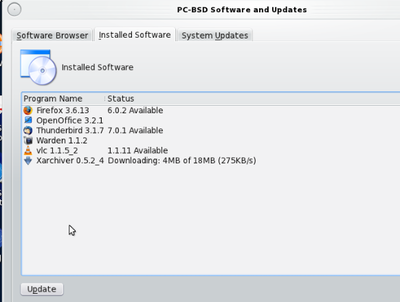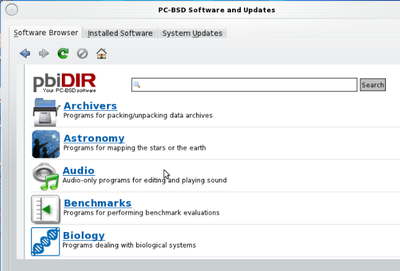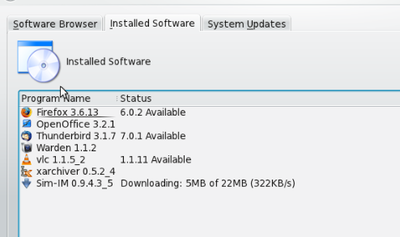COMP 3000 2011 Report II:PC-BSD: Difference between revisions
| Line 118: | Line 118: | ||
'''RPM''' | '''RPM''' | ||
Version Number : 3.0.6 | Version Number : 3.0.6, Sep 13, 2000 <ref>http://rpm.org/releases/historical/rpm-3.0.x/</ref> | ||
latest version: 4.9.1.2 Sep 29, 2011 <ref>http://www.rpm.org/wiki/Releases/4.9.1.2</ref> | |||
reason: it is the Red Hat Package Manager. It can manage *.rpm file. RPM is part of Linux standard base. PC-BSD is Linux, and it also support .rpm package to be installed so that this distribution will be more powerful to handle packages. RPM is powerful command line and it is free software under GNU GPL. | |||
'''Gwenview''' | '''Gwenview''' | ||
version number : 1.2.92 Aug 21, 2005 Image viewer for KDE <ref>http://rpmfind.net/linux/RPM/sourceforge/g/project/gw/gwenview/gwenview/1.2.92/gwenview-1.2.92-0.1.101mdk.i586.html</ref> | |||
latest version: 4.7.3, Oct 28, 2011 <ref>ftp://ftp.kde.org/pub/kde/stable/latest/src/</ref> | |||
reason: Gwenview is part of the kdegraphics module. Gwenview is a fast and easy to use image viewer/browser for KDE. PC-BSD use KDE for better user experience. Gwenview is inside KDE. | |||
'''ARK''' | '''ARK''' | ||
Revision as of 00:34, 17 November 2011
Part II
Software Packaging
This distribution is PC-BSD. Linux package formats are the different file formats used to package software for various Linux distributions. Here in PC-BSD, it mainly uses Binary Packaging format -- pbi<ref>http://en.wikipedia.org/wiki/List_of_software_package_management_systems#PC-BSD</ref>. This distribution uses lots of graphic utilities<ref>http://www.pcbsd.org/about/pc-bsd-project/utilities</ref> to provide front-end to useful FreeBSD features, such as Software Management Utility, Virtual Environment Utility, Backup Utility, Ports Jails Utility and so on.
In the distribution, it use we can use pkg management utilities<ref>http://wiki.pcbsd.org/index.php/Ports_Jail</ref> to manage packages.In command line, it will use "pkg_info" to get a list of installed packagers, "pkg_add" to add packages, and "pkg_delete" to remove packages. In PC-BSD 9.0, it will use PBI manager<ref>http://wiki.pcbsd.org/index.php/PBI_Manager</ref>, which will use "pbi_info", "pbi_add", "pbi_delete" instead. The PC-BSD repository<ref>http://en.wikipedia.org/wiki/PC-BSD#Package_management</ref> is http://www.pbidir.com/. The software catalog can found from there.
Because PC-BSD provides Graphic tools for desktop user, there is utility Software Management to do some thing like pkg management. Here it is:
There is utility called Software Management (in PC-BSD version 8.2), which can get a list of installed packages, except for system packages installed during installation of this distribution, like this picture:
PC-BSD is aim to give user easy used install/remove package experience like Windows or Mac OS. The applications are installed from a simple downloaded file with graphic prompts. Software Management is also a very useful utility to find desired software and install them by clicking the link. Remove is also a simply mouse click operation. There is a website browser in the Software Management and search engine for keyword search and different catalogs for selections.
After made decision, it can downloaded the software by clicking the download link. And it will automatically download and install the packages/software.
There is also a remove button under "Installed Software" menu. Simply choose the package needed to remove, and click remove.
The software catalog for this distribution can be found in the Software Browser of Software Management. There are many selections: Archives, Astronomy, Audio, Benchmarks, Biology, CAD, Communications, Databases, Desktop Utilities, Development, E-Mail, Editors, Educational, Emulators, File Transfer & Utilities, Finance, Games, Graphics, IRC, Japanese, Java, Languages, Math, Miscellaneous, Multimedia, Network-IM, Network-Management, Network-P2P, Network-Utilities, News, Non-Port, Polish, Ports-Management, Print, Science, Security, Shells, System Utilities, Text Processing, The Warden-Inmates, Web, X11, X11-File Managers and X11-Window Managers.
There is too many packages to choose, part of catalog information can be seen from the previous picture.
Major package versions
Report on the version numbers and upstream source (URL of original source) for some of the major software packages included in your distribution as part of the standard install:
Linux Kernel or other kernel libc X.org or other GUI foundation Major GUI toolkits (Gtk+, Qt, Motif, etc.) shell (bash, csh, etc.) utilities (ls, ps, busybox) software packaging (rpm, dpkg, etc.) Web browser email other packages that are key to system usage
CBold texthoose at least 10 packages that fit into this list (you don't need to cover every category) and report the following:
What is the vintage of the included package? How old is it, and how far is it behind the latest stable release for this package? How heavily has the package been modified by the distribution authors? (You'll need to figure out how to determine this.) Why do you think this particular package was chosen for this distribution's standard install? You may speculate, but please make an argument informed by relevant facts.
Use "diff" command to compare two packages, one is downloaded from official website & another one is resource from this distribution. "diff" will compare two binary code line by line. After that we can see what's the difference and what has been modified by distribution authors.
// qliu1
X.org:
version number: 11.0, release 7.5 (Oct 26, 2009) <ref>http://www.x.org/wiki/Releases/7.5</ref>.
latest version: X11R7.6 on Dec 20, 2010.<ref>http://www.x.org/wiki/Releases/7.6</ref>
reason: Xorg supports several mechanisms for supplying/obtaining configuration and run-time parameters: command line options, environment variables, the xorg.conf configuration file, auto-detection, and fallback defaults. In PC-BSD, it completes distribution meta-port.
Qt
version number: 4.7.1, released Nov 9, 2010 <ref>http://labs.qt.nokia.com/2010/11/09/qt-4-7-1-released/</ref>
latest version: 4.7.4, released Sep 1, 2011 <ref>http://labs.qt.nokia.com/2011/09/01/qt-4-7-4-released/</ref>
reason: Qt SDK combines the Qt framework with tools designed to streamline the creation of applications for Symbian and Maemo, MeeGo (Nokia N9) in addition to desktop platforms, such as Microsoft Windows, Mac OS X, and Linux. PC-BSD needs that platform.
gtk
version number: 2.22.1, Nov 15, 2010 <ref>http://mail.gnome.org/archives/ftp-release-list/2010-November/msg00145.html</ref>
latest version: 2.24.8, Nov 10, 2011 <ref>http://mail.gnome.org/archives/gtk-devel-list/2011-November/msg00026.html</ref>
reason: Gimp toolkit for X11 GUI. It is is a multi-platform toolkit for creating graphical user interfaces, which is PC-BSD's need.
bash
version number: 4.1.9, March, 2010 <ref>ftp://ftp.gnu.org/gnu/bash/bash-4.1-patches/bash41-009</ref>
latest version: 4.2.10, April, 2011 <ref>ftp://ftp.cwru.edu/pub/bash/bash-4.2-patches/bash42-010</ref>
reason: The GNU Project's Bourne Again SHell. Bash is the shell, or command language interpreter, that will appear in the GNU operating system.
pth
version number: 2.0.7 Jun 8, 2006 <ref>http://www.gnu.org/s/pth/</ref>
latest version: current is the latest version
reason: Pth is a very portable POSIX/ANSI-C based library for Unix platforms which provides non-preemptive priority-based scheduling for multiple threads of execution inside event-driven applications. PC-BSD want to give user better experience in desktop like Windows or Mac OS, multi-thread is needed.
ruby
version number: 1.8.7 June 1, 2008 <ref>http://www.ruby-lang.org/en/feeds/news.rss</ref>
latest version: 1.9.3 Oct 30, 2011 <ref>http://www.ruby-lang.org/en/feeds/news.rss</ref>
modification: A dynamic, open source programming language with a focus on simplicity and productivity. Most Linux distribution will use that, so do PC-BSD. It has an elegant syntax that is natural to read and easy to write.
KDE (this includes Konqueror web browser and KMail)
version number: KDE version 4.5.5, Jan 4, 2011 <ref>http://techbase.kde.org/Schedules/KDE4/4.5_Release_Schedule#January_4th.2C_2011:_Release_KDE_SC_4.5.5</ref>
latest version: 4.7.3 Nov, 2011 <ref>http://www.kubuntu.org/news/by-date/201111</ref>
reason: KDE offers a full suite of user workspace applications which allow interaction with these operating systems in a modern, graphical user interface. And PC-BSD need good GUI to provide nice experience for desktop user, KDE is a good choice
// todetoyi
RPM
Version Number : 3.0.6, Sep 13, 2000 <ref>http://rpm.org/releases/historical/rpm-3.0.x/</ref>
latest version: 4.9.1.2 Sep 29, 2011 <ref>http://www.rpm.org/wiki/Releases/4.9.1.2</ref>
reason: it is the Red Hat Package Manager. It can manage *.rpm file. RPM is part of Linux standard base. PC-BSD is Linux, and it also support .rpm package to be installed so that this distribution will be more powerful to handle packages. RPM is powerful command line and it is free software under GNU GPL.
Gwenview
version number : 1.2.92 Aug 21, 2005 Image viewer for KDE <ref>http://rpmfind.net/linux/RPM/sourceforge/g/project/gw/gwenview/gwenview/1.2.92/gwenview-1.2.92-0.1.101mdk.i586.html</ref>
latest version: 4.7.3, Oct 28, 2011 <ref>ftp://ftp.kde.org/pub/kde/stable/latest/src/</ref>
reason: Gwenview is part of the kdegraphics module. Gwenview is a fast and easy to use image viewer/browser for KDE. PC-BSD use KDE for better user experience. Gwenview is inside KDE.
ARK
Initialization
Here describe how your distribution initializes itself. Specifically, give an outline of what programs are executed and in what order. Also document how you discovered this information. You do not need to include every program; however, you should be able to identify at least five major programs that are run.
Note that you should provide an explanation for how all of the major processes end up running on a fully initialized system.
Upon initialization of Pcbsd, the following happens and in the order they occur
- ffserver is the run after the network service is run, it enables or disables the network.
- fusefs is run after systctl is run before mountlate is run.
- pcbsdinit Is run after DAEMON is run it starts the system scripts.
- mdnsd also runs after daemon is activated,it runs a pid file from the sbin directory.
- oss also runs after deamon, it handles the sound system.
- netatalk runs after daemon, it provides atalkd papd cnid_metad timelord afpd,
- snddetect runs after daemon, it provides sound detect, it first removes sound flag then detects if system has sound or not.
- wacom runs after filesystem, it offers setup and cleanup to configure Xorg for use of the driver or remove the configuration settings.
Reference
<references/>


